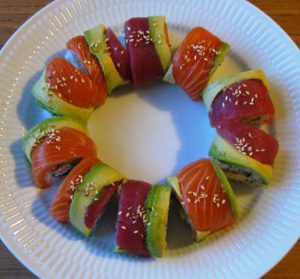 The Japanese have a slightly different view of sushi.
The Japanese have a slightly different view of sushi.
In Japan it is believed that all types of high quality fish can be used for sushi. This means that most sushi restaurants have 15-20 different fish on the menu. With such a large selection the Japanese prefer to eat nigiri.
But before a fish enters a sushi bar the quality of the fish has to meet the specific criteria.
On the class Sushi for beginners you will hear the quality of the fish is decided.
_
Zoë has held sushi courses and cooking classes for A. P. Moller – Maersk, Hugo Boss Nordic, Novo Nordisk, Novartis, Velux, Gorrissen Federspiel, Beierholm revision, Elbek & Vejrup and many more.








